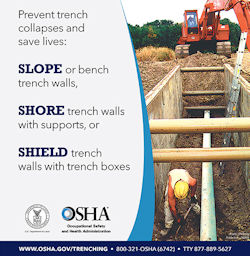25.B.02 Rescue Plan and Procedures.
The employer is required to provide prompt rescue to all buried workers.
Trench fatality and Response - NYSDOH
- A written rescue plan must be prepared by the CP or a RPE, submitted and accepted by the GDA prior to beginning operations and maintained when workers are working at depths of over 5 ft (1.5 m).
- The plan must contain provisions for self-rescue and assisted rescue of any worker who is buried during a cave-in including rescue equipment. If other methods of rescue are planned (i.e. by a jurisdictional, public or Government emergency rescue agencies), it must be indicated in the rescue plan including how to contact and summon the agency to the mishap site.
- Personnel conducting rescue must be trained accordingly.
25.B.03 All wells, calyx holes, pits, shafts, etc., must be barricaded or covered.
25.B.04 Excavations must be backfilled as soon as possible. Upon completion of exploration and similar operations, test pits, temporary wells, calyx holes, etc., must be backfilled immediately.
25.B.05 Walkways or bridges must be provided with standard guardrails (as defined in Section 21.F.01) where people or equipment are required or permitted to cross over excavations.
25.B.06 Where personnel are required to enter excavations/trenches over 4 ft (1.2 m) in depth, sufficient stairs, ramps, or ladders must be provided to require no more than 25 ft (7.6 m) of lateral travel.
- At least two means of exit must be provided for personnel working in excavations. Where the width of the excavation exceeds 100 ft (30.4 m), two or more means of exit must be provided on each side of the excavation.
- When access to excavations in excess of 20 ft (6 m) in depth is required, ramps, stairs, or mechanical personnel hoists must be provided.
25.B.07 Ramps.
> See Sections 24.B. and 24.F.
- Ramps used solely for personnel access must be a minimum width of 4 ft (1.2 m) and provided with standard guardrails. > See Section 21.F.01.
- Ramps used for equipment access must be a minimum width of 12 ft (3.6 m). Curbs not less than 8-in x 8-in (20.3-cm x 20.3-cm) timbers, or equivalent protection, must be provided. Equipment ramps must be designed and constructed in accordance with accepted engineering practice.
25.B.08 Ladders used as access ways must extend from the bottom of the excavation to not less than 3 ft (0.9 m) above the surface.
Knowledge Check Choose the best answer for the question.
25-5. What is required for access to excavations more than 20 ft (6 m) in depth?
You forgot to answer the question!

